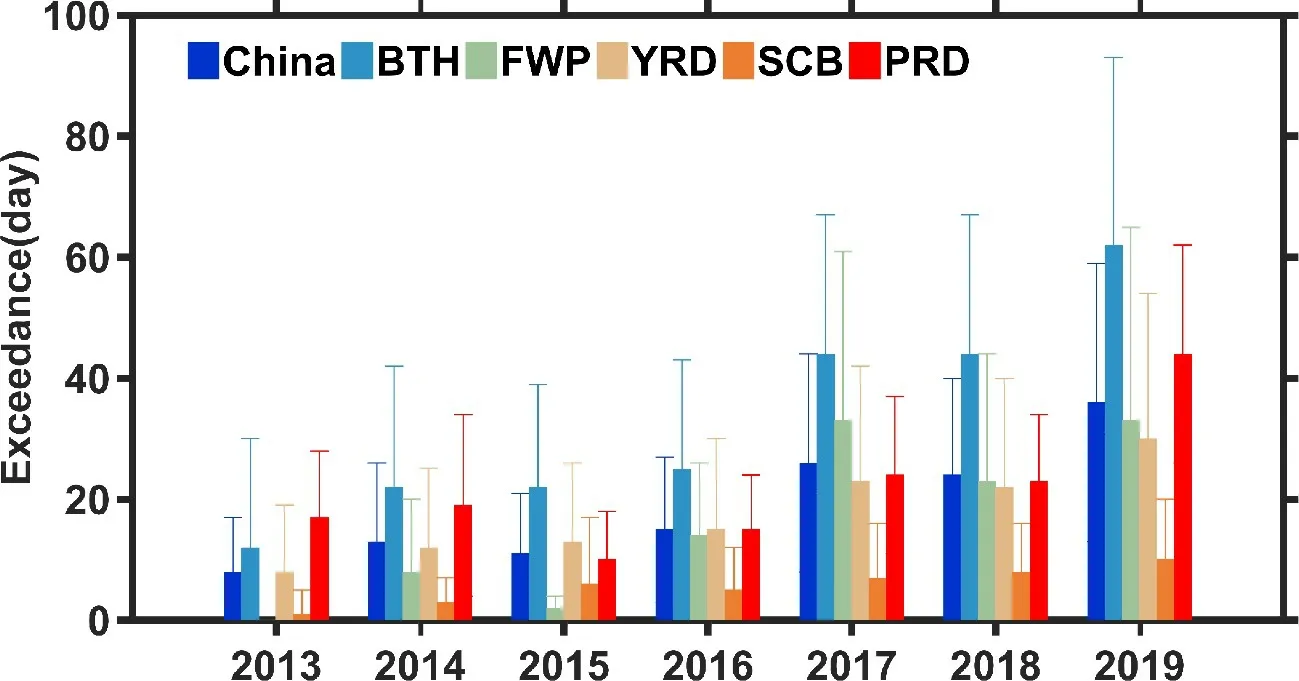Electronic Supplementary Material to:A New Index Developed for Fast Diagnosis of Meteorological Roles in Ground-Level Ozone Variations*
Weihua CHEN, Weiwen WANG, Shiguo JIA, Jingying MAO, Fenghua YAN, Lianming ZHENG,Yongkang WU, Xingteng ZHANG, Yutong DONG, Lingbin KONG, Buqing ZHONG,Ming CHANG, Min SHAO, and Xuemei WANG
1Guangdong-Hongkong-Macau Joint Laboratory of Collaborative Innovation for Environmental Quality,Institute for Environmental and Climate Research, Jinan University, Guangzhou 510632, China
2School of Atmospheric Sciences, Guangdong Province Key Laboratory for Climate Change and Natural Disaster Studies,Sun Yat-sen University, Guangzhou 510275, China
3Key Laboratory of Vegetation Restoration and Management of Degraded Ecosystems, South China Botanical Garden,Chinese Academy of Sciences, Guangzhou 510650, China

Table S1. Statistics for T2 and WS during 2013-2019.

Table S2. Fitting parameters for historical 90th percentile MDA8-O3 and MSI in the key regions with 95% confidence bounds.

Table S3. Summary of the meteorological contribution to O3 concentration.

Fig. S1. Scatter plot of MDA8-O3 concentration versus dimensionless meteorological parameters. The correlation coefficient is inserted.

Fig. S2. Scatter plot of observed (OBS) versus simulated (SIM) (a) T2 and (b) WS in the study regions over China from 2013 to 2019.

Fig. S3. Scatter plot of observed (OBS) versus simulated(SIM) SW. Blue dots represent daily solar radiation at JNU from 1 October 2019 to 31 December 2019; orange dots represent monthly solar radiation over China (CMA) from 2013 to 2019.

Fig. S4. Scatter plot of MSI versus observed MDA8-O3 in the key regions over China during 2013-2019 (shaded areas are the 95% confidence interval).

Fig. S5. Annual O3 exceedance (days) in the study regions over China during 2013-2019.

Fig. S6. Trends of the 12-month moving average (a)Photochemical Reaction Conditions (P RC), (b) Physical Dispersion Capacity (P DC), and (c) Meteorology Synthetic Index (M SI) in the study regions during 2013-2019. The slopes for the linear regression at the 95% confidence level are shown in each plot.
 Advances in Atmospheric Sciences2022年3期
Advances in Atmospheric Sciences2022年3期
- Advances in Atmospheric Sciences的其它文章
- Electronic Supplementary Material to:Seasonal Prediction of Summer Precipitation over East Africa Using NUIST-CFS1.0*
- Electronic Supplementary Material to:Detection and Attribution of Changes in Thermal Discomfort over China during 1961-2014 and Future Projections*
- The 16th Workshop on Antarctic Meteorology and Climate and 6th Year of Polar Prediction in the Southern Hemisphere Meeting
- A New Method of Significance Testing for Correlation-Coefficient Fields and Its Application
- Observations of Dynamic Turbulence in the Lower Stratosphere over Inner Mongolia Using a High-resolution Balloon Sensor Constant Temperature Anemometer
- The Linkage between Midwinter Suppression of the North Pacific Storm Track and Atmospheric Circulation Features in the Northern Hemisphere
